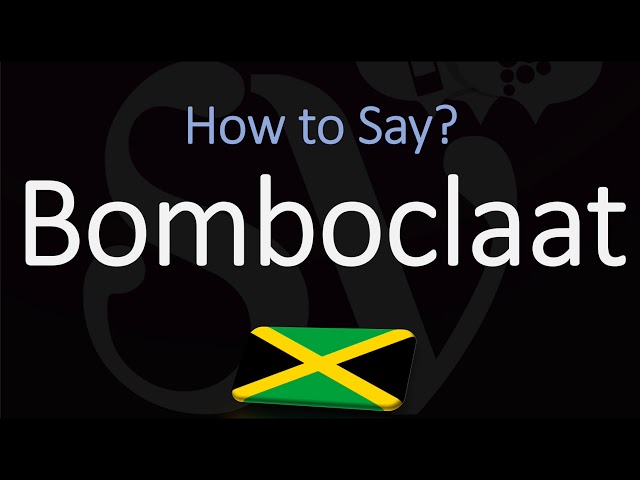What “Bomboclat” Really Means
“Bomboclat” is a Jamaican Patois word that originated from the African slaves on the island of Jamaica in the 17th century. It was primarily used to describe the cloth their slave masters used to wipe their bottoms and that the slaves were forced to clean.The word is derived from “bombo,” meaning “bottom,” and “clat,” meaning “cloth.” When paired together, it translates to “bottom cloth” in standard English.In Jamaica today, “bomboclat” is considered a curse or swear word, often used when someone is extremely frustrated or stressed. It holds a similar effect as the “S-word” or the “F-bomb” in the United States and is seen as disrespectful by the older generation.
The Deeper Meaning of “Bomboclat”
The word “bomboclat” has a much deeper and more complex history than just a simple curse word. It is a reflection of the painful legacy of slavery and colonialism in Jamaica.
The Origins of “Bomboclat”
During the transatlantic slave trade, millions of Africans were forcibly brought to the Caribbean islands to work on plantations owned by European colonizers. The conditions these enslaved people faced were brutal and dehumanizing.One particularly degrading practice was the use of rags, or “clats,” by the slave masters to wipe their bottoms after using the bathroom. These dirty rags would then be given to the slaves to clean, further emphasizing the power dynamic and lack of dignity afforded to the enslaved.The word “bomboclat” emerged as a way for the slaves to reclaim their humanity and express their frustration with this demeaning practice. By combining the words “bombo” (bottom) and “clat” (cloth), they created a term that simultaneously acknowledged their oppression and asserted their own worth and dignity.
The Evolution of “Bomboclat”
Over time, “bomboclat” evolved from a term of resistance into a more general expression of anger, frustration, and disbelief. It became a way for Jamaicans to voice their displeasure with the ongoing social and economic inequalities that persisted long after the abolition of slavery.Today, “bomboclat” is still used in this way, but it has also taken on a more casual, colloquial meaning. It is often used as an exclamation or interjection, similar to how “damn” or “fuck” might be used in English.
The Controversy Surrounding “Bomboclat”
Despite its widespread use in Jamaican culture, “bomboclat” remains a controversial and sensitive term. Some view it as a necessary expression of the island’s turbulent history, while others see it as a vulgar and disrespectful word that should be avoided.This debate is particularly pronounced among the older generation in Jamaica, who may have a more direct connection to the origins of the term and the trauma of slavery. Younger Jamaicans, on the other hand, may use “bomboclat” more casually, without fully understanding its historical significance.
Conclusion
“Bomboclat” is a complex and multifaceted word that reflects the deep-rooted struggles and resilience of the Jamaican people. While it may be seen as a curse word by some, it also serves as a powerful reminder of the island’s painful past and the ongoing fight for social justice and equality.
Frequently Asked Questions
- What is the origin of the word “bomboclat”?
- “Bomboclat” originated from the African slaves on the island of Jamaica in the 17th century.
- What does “bomboclat” mean?
- “Bomboclat” translates to “bottom cloth” in standard English. It is derived from “bombo,” meaning “bottom,” and “clat,” meaning “cloth”.
- Is “bomboclat” a curse word?
- Yes, in Jamaica today, “bomboclat” is considered a curse or swear word, often used when someone is extremely frustrated or stressed.
- How is “bomboclat” used in Jamaica?
- “Bomboclat” is used in a similar way as the “S-word” or the “F-bomb” in the United States. It is seen as disrespectful by the older generation in Jamaica.
- Is “bomboclat” commonly used in textbooks?
- No, the specific part of slave history related to “bomboclat” is commonly left out of textbooks published in colonial nations.
- What is the historical significance of the word “bomboclat”?
- “Bomboclat” originated from the African slaves on the island of Jamaica in the 17th century, as a way to express their frustration with the degrading practice of using dirty rags to wipe their slave masters’ bottoms.
- How has the meaning of “bomboclat” evolved over time?
- Initially, “bomboclat” was a term of resistance and a way for slaves to assert their humanity. Over time, it evolved into a more general expression of anger, frustration, and disbelief, reflecting the ongoing social and economic inequalities in Jamaica.
- Why is “bomboclat” a controversial term?
- “Bomboclat” remains a controversial and sensitive term, with some viewing it as a necessary expression of Jamaica’s turbulent history, while others see it as a vulgar and disrespectful word that should be avoided. This debate is particularly pronounced among the older generation in Jamaica.
- How do younger Jamaicans use the term “bomboclat”?
- Younger Jamaicans may use “bomboclat” more casually, without fully understanding its historical significance. This has led to further debate and controversy within the Jamaican community.
- What is the importance of understanding the context and history of “bomboclat”?
- It is important to approach “bomboclat” with respect and understanding, acknowledging its historical context and the diverse perspectives that exist within the Jamaican community. This helps to foster a more nuanced and meaningful dialogue around this complex and sensitive term.
| Term | Definition | Source |
|---|---|---|
| Patois | A blend of broken English and African dialects commonly spoken on the island of Jamaica | Jamaican Patois |


